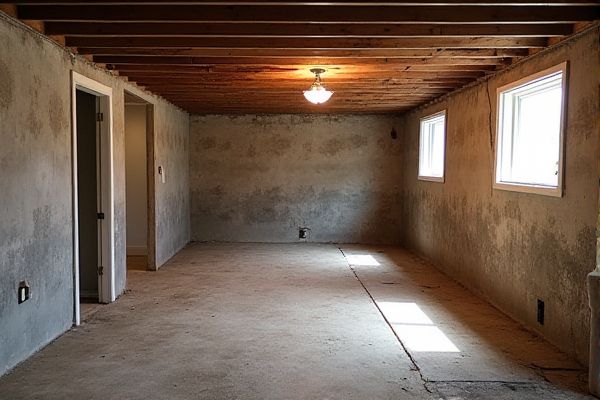
A crawl space offers limited access beneath your home, typically just enough for maintenance, while a partial basement provides more usable storage or living space with higher ceilings and better insulation. Discover the key differences and decide which option best suits your home's needs by reading the rest of the article.
Table of Comparison
| Feature | Crawl Space | Partial Basement |
|---|---|---|
| Definition | Shallow space between ground and first floor | Basement with partial below-ground walls |
| Depth | 1-3 feet | 4-8 feet or more |
| Cost | Lower construction and maintenance cost | Higher initial and maintenance cost |
| Usable Space | Limited storage, not habitable | Partial usable space, can be finished |
| Moisture Control | Requires vapor barriers and ventilation | Better moisture control, but still needs waterproofing |
| Access | Small crawl access openings | Standard access via stairs or door |
| Foundation Type | Concrete or masonry perimeter walls | Concrete walls supporting structure and floor |
| Energy Efficiency | Less insulated, potential heat loss | Better insulated, contributes to energy savings |
| Common Uses | Plumbing, electrical access, ventilation | Living space, storage, mechanical rooms |
Introduction to Crawl Spaces and Partial Basements
Crawl spaces and partial basements serve as common foundation options in residential construction, each offering distinct benefits based on soil conditions and climate. Crawl spaces provide elevated access beneath the home, improving ventilation and ease of inspecting plumbing and wiring, while partial basements extend below grade for additional storage or living space without the full height of a traditional basement. Understanding the structural differences and site suitability is essential for choosing between a crawl space or partial basement to optimize home durability and energy efficiency.
Defining Crawl Spaces: Features and Functions
A crawl space is a shallow, unfinished area beneath a home, typically used for access to plumbing, wiring, and HVAC systems, with a height usually between 18 inches and 4 feet. Unlike partial basements, crawl spaces do not offer full living or storage space but provide essential ventilation and moisture control to protect the home's foundation. Understanding this distinction helps you choose the best foundation option for your property's structural and maintenance needs.
What Is a Partial Basement? Key Characteristics
A partial basement is a foundational structure with walls extending below ground level but only covering a portion of the building's footprint, offering limited usable space compared to a full basement. Key characteristics include reduced excavation costs, easier access for repairs or upgrades, and potential for limited storage or utility areas without full below-grade rooms. This contrasts with crawl spaces, which are shallow, uninhabitable voids meant primarily for access to plumbing and electrical systems.
Construction Differences Between Crawl Spaces and Partial Basements
Crawl spaces are shallow, typically 1 to 3 feet high, constructed with a foundation wall and floor slabs or dirt, providing access beneath the home without full-height walls. Partial basements extend deeper, usually 4 to 8 feet, featuring full-height walls made of poured concrete or concrete blocks, creating usable space beneath the house. Understanding these construction differences helps you decide on the best option for ventilation, moisture control, and additional storage or living area.
Pros and Cons of Crawl Spaces
Crawl spaces offer easier access to plumbing and electrical systems compared to partial basements, reducing repair costs and time. However, they can be prone to moisture buildup and pest infestations, which may lead to structural damage or health issues if not properly ventilated and sealed. Your choice depends on balancing cost-efficiency and maintenance needs against potential risks related to humidity and insulation.
Advantages and Disadvantages of Partial Basements
Partial basements offer increased storage space and better protection against flooding compared to crawl spaces, with easier access to utilities for maintenance. However, they tend to be more expensive to construct and can have moisture issues if not properly waterproofed. Your choice depends on balancing budget constraints with the need for space and long-term durability.
Cost Comparison: Crawl Space vs Partial Basement
A crawl space generally costs 30-50% less to build than a partial basement due to reduced excavation and foundation material requirements. While a partial basement provides additional storage or living space, it typically adds $10,000 to $25,000 more on average to construction expenses. Understanding your budget constraints and long-term value can help you decide whether a crawl space or partial basement best suits Your home building project.
Insulation, Moisture, and Ventilation Considerations
Crawl spaces typically require vapor barriers and encapsulation to manage moisture effectively and prevent insulation damage, while partial basements benefit from insulated walls and floors to enhance thermal efficiency and reduce mold risk. Proper ventilation in crawl spaces is essential to control humidity and avoid wood rot, whereas partial basements often use mechanical ventilation to maintain air quality and minimize condensation. Choosing between the two involves assessing local climate conditions and the ability to implement moisture control and adequate insulation strategies.
Which Option Is Better for Home Value and Resale?
A partial basement generally offers higher home value and better resale potential due to increased usable living space and storage options, making it more attractive to buyers. Crawl spaces, while less expensive to build and maintain, typically provide limited functionality and may raise concerns about moisture and structural issues, potentially lowering market appeal. Real estate data consistently shows homes with partial basements tend to command higher prices and quicker sales compared to those with crawl spaces.
Choosing the Right Foundation for Your Home
Choosing the right foundation for your home involves evaluating crawl space and partial basement options based on soil conditions, climate, and budget. Crawl spaces provide better ventilation and easier access to plumbing and electrical systems, while partial basements offer increased storage and potential living space. Understanding regional building codes and long-term maintenance needs ensures the foundation supports structural integrity and energy efficiency effectively.
 homyna.com
homyna.com